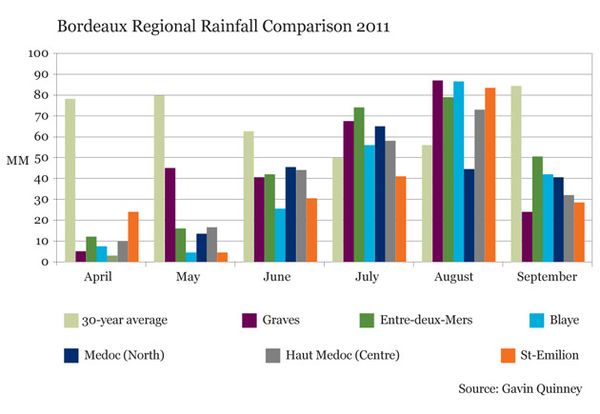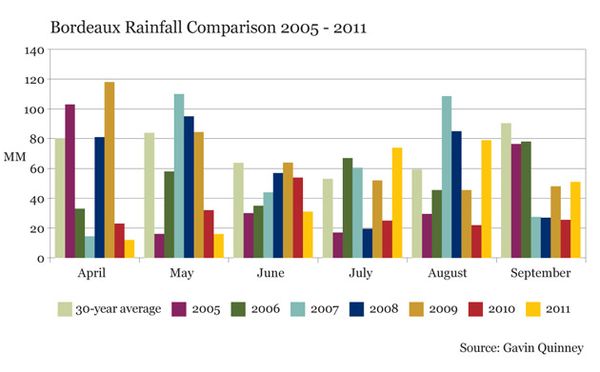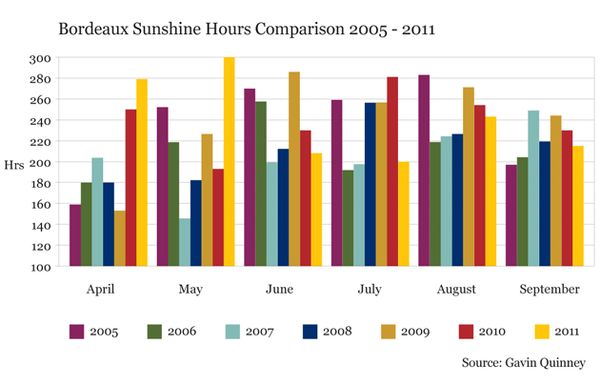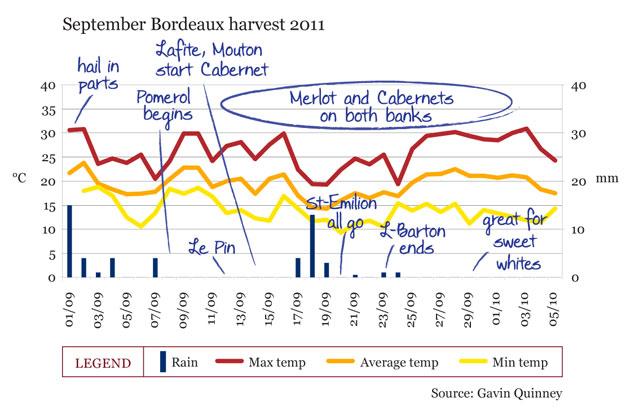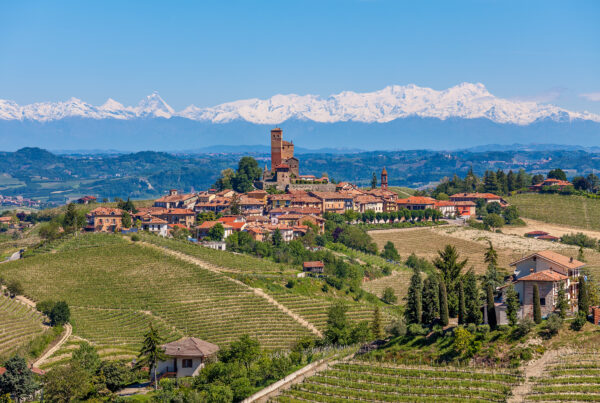Guest blog from Gavin Quinney
Liv-ex is opening up the blog once again to Bordeaux grower, winemaker and writer Gavin Quinney (@GavinQuinney) for an inside view on the weather in 2011. You can read his report on the 2010 vintage here.
—
As the trade and press prepare to descend on Bordeaux for the annual en primeur tastings in late March and early April, here are my weather charts for the 2011 season, compared to recent vintages.
A summary of what happened in the vineyard:
1. Early budbreak, very warm spring, drought until July.
2. An up-and-down summer.
3. Low threat of mildew early on, risk of rot later.
4. An early harvest under September sun.
5. Picking dates a gamble between ripeness and rot.
6. Sorting and selection key.
7. Quality and yield vary from one estate to another.
A dry year, again
From March to September 2011, the cumulative rainfall in Bordeaux – on average across all sectors – was 270mm, way below the 30-year average of 430mm. In Bordeaux, we like to draw attention to dry years being great ones: 2009 was a dry year, and 2010 exceptionally so. The key difference with 2011 was in the timing.
The monthly rainfall was far lower than normal in March, April and May, lower too in June (when most of the rain fell on one day, the 6th) and also in September. It was generally higher in the crucial summer months of July and August.
A good way to look at this chart (Bordeaux Rainfall Comparison 2005-2011) is to visualise the cycle of how the months flow for each year separately. The 30-year average is to be expected – more rain in the spring, then less in summer and higher rainfall again in September. Then see how 2011 moves in the opposite direction. It was, if you like, an upside down year.
Compare this, then, with a great year like 2009, which saw lots of rain in April, then below average in May, June and July, then drier in August and September (and when the rain came then, it was welcome). Contrast this with the drought of 2010.
As well as having precious little rain from March to June 2011, temperatures were far higher in April and May than normal. An early budbreak in March, as visitors to the primeur tastings last year might recall, was followed by summer-like conditions.
Fine weather during the crucial flowering of the vines from mid-May to early June also suggested an early harvest – and a good crop size, although parts of Margaux, the Graves and Sauternes were hit by hail in late April.
Philippe Dhalluin of Mouton Rothschild was one of many winemakers who told me in June that tests in the vineyard showed that the vines were three weeks ahead.
June itself was slightly cooler than the norm before a fearsome heatwave late in the month, during which some exposed bunches were sunburnt. The lack of rain to this point had helped to reduce the risk of mildew but there was cause for concern as many vines suffered and, heading into July, their development had become blocked.
The overall feeling was that, having experienced two very dry summers in 2009 and 2010, further drought would lead to serious problems.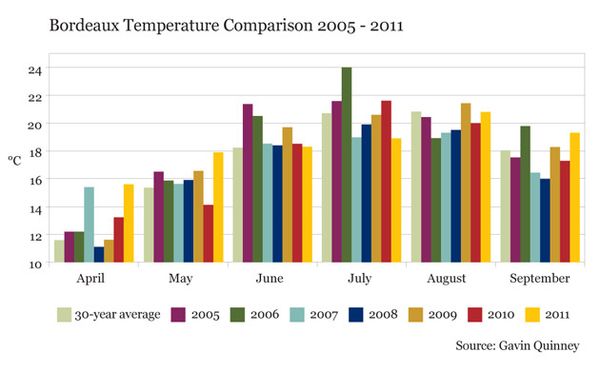
At last, we had some rain in the second week of July. We then had just a little too much rain during the summer holidays, off and on: 153mm here in the two months combined compared to the 30-year average of 106mm.
July was also much cooler than normal but the rain in the middle of the month, then sunshine at the end, helped the grapes to change colour, so we were still a fortnight ahead. Merlot and Cabernet grapes on either bank in Bordeaux on 1stAugust in 2010 were still green, mostly. In 2011, they were red.
August was a month of highs and lows, even if the stats show overall that temperatures were slightly cooler than the average. Heavy rain at first, then chilly, then sunny and dry, then very hot and humid, plenty of rain on the 23rd, then sunny again.
Some vines, with their timing already out of whack, starting growing new leaves, rather than concentrating on ripening grapes.
The dry whites were picked from the middle of the month onwards, with many chateaux harvesting earlier than ever before.
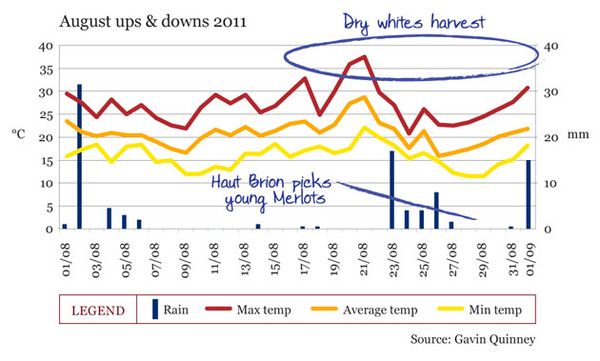
When to pick: balancing ripeness with the risk of rot
This is a telling graph. A quick comparison of the threat of botrytis in 2011 with previous vintages reveals the challenge faced by winemakers. It's important to note that the results are not the same for every region in Bordeaux – this data is from my local weather station.
With a relatively long ‘hang-time’ from the early flowering in mid and late-May, and then a mixed summer, chateaux had to choose the timing of the harvest carefully, balancing phenolic ripeness on the one hand and the risk of rot on the other.
I saw no rot at all on red grapes in September in the last three years, which was not the case in 2011.
There's been enormous investment in sophisticated grape-sorting equipment in the last three years in Bordeaux. In 2009 and 2010, these machines and techniques were put to the test but made little real difference. Conditions in 2011 gave them the chance to earn their keep. 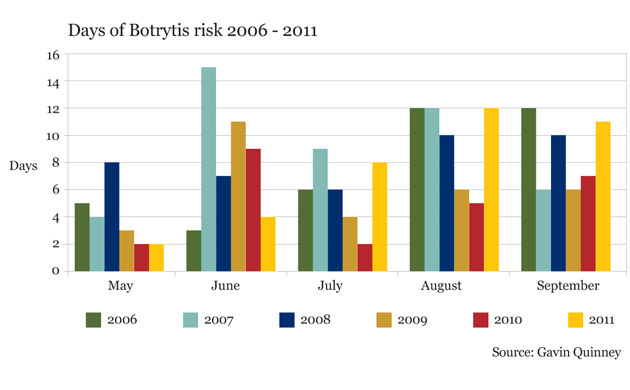 Early harvest under September sun
Early harvest under September sun
September is a crucial month. Fine weather just before and during the harvest can seal a great vintage, as in 2000, 2005, 2009 and 2010, or it can save a vintage after a wet summer, as in 2002, 2004 and 2007.
If the rain of the last week of August and at the start of September 2011 had carried on for any longer, hopes for a good vintage would have ebbed away. Fortunately, despite a difficult start and a wet weekend in the middle of the month, September 2011 was sunny.
A noticeable difference was that almost the entire red harvest was completed in September. Lafite, for example, began the harvest of the young Cabernet Sauvignon vines in Pauillac on the 14th, whereas last year, they didn’t start their Cabernet until the 4th of October.
The only other recent vintage that was picked in September was 2003, an altogether different year with its raging hot summer.
So, in summary, an early harvest, with challenging conditions in the vineyard – drought for the four months to early July, then a tricky summer, ending with a threat of rot. Fine weather in September certainly helped with the timing and quality of the harvest. It'll be fascinating to see how the wines have turned out.

